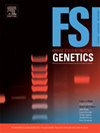期刊简介
Journal Title:Forensic Science International-genetics
Forensic Science International: Genetics is the premier journal in the field of Forensic Genetics. This branch of Forensic Science can be defined as the application of genetics to human and non-human material (in the sense of a science with the purpose of studying inherited characteristics for the analysis of inter- and intra-specific variations in populations) for the resolution of legal conflicts.
The scope of the journal includes:
Forensic applications of human polymorphism.
Testing of paternity and other family relationships, immigration cases, typing of biological stains and tissues from criminal casework, identification of human remains by DNA testing methodologies.
Description of human polymorphisms of forensic interest, with special interest in DNA polymorphisms.
Autosomal DNA polymorphisms, mini- and microsatellites (or short tandem repeats, STRs), single nucleotide polymorphisms (SNPs), X and Y chromosome polymorphisms, mtDNA polymorphisms, and any other type of DNA variation with potential forensic applications.
Non-human DNA polymorphisms for crime scene investigation.
Population genetics of human polymorphisms of forensic interest.
Population data, especially from DNA polymorphisms of interest for the solution of forensic problems.
DNA typing methodologies and strategies.
Biostatistical methods in forensic genetics.
Evaluation of DNA evidence in forensic problems (such as paternity or immigration cases, criminal casework, identification), classical and new statistical approaches.
Standards in forensic genetics.
Recommendations of regulatory bodies concerning methods, markers, interpretation or strategies or proposals for procedural or technical standards.
Quality control.
Quality control and quality assurance strategies, proficiency testing for DNA typing methodologies.
Criminal DNA databases.
Technical, legal and statistical issues.
General ethical and legal issues related to forensic genetics.
中文简介
《国际法医科学:遗传学》是法医遗传学领域的顶尖期刊。法医学的这一分支可以定义为将遗传学应用于人类和非人类材料(从科学的意义上讲,其目的是研究遗传特征以分析种群间和种群内的变化)以解决法律冲突。
该期刊的范围包括:
人类多态性的法医学应用。
亲子关系和其他家庭关系的测试、移民案件、刑事案件中生物染色和组织的分型、通过 DNA 测试方法识别人类遗骸。
描述具有法医学意义的人类多态性,特别关注 DNA 多态性。
常染色体 DNA 多态性、小卫星和微卫星(或短串联重复序列,STR)、单核苷酸多态性 (SNP)、X 和 Y 染色体多态性、mtDNA 多态性以及任何其他类型的具有潜在影响的 DNA 变异法医应用。
用于犯罪现场调查的非人类 DNA 多态性。
具有法医意义的人类多态性的群体遗传学。
群体数据,尤其是用于解决法医问题的 DNA 多态性。
DNA 分型方法和策略。
法医遗传学中的生物统计学方法。
法医问题(如亲子关系或移民案件、刑事案件、身份识别)中 DNA 证据的评估,经典和新统计方法。
法医遗传学标准。
监管机构关于方法、标记、解释或策略或程序或技术标准提案的建议。
质量控制。
质量控制和质量保证策略,DNA 分型能力测试方法论。
犯罪 DNA 数据库。
技术、法律和统计问题。
与法医遗传学相关的一般伦理和法律问题。
期刊点评
Forensic Science International-genetics创刊于2007年,由Elsevier Ireland Ltd出版商出版,收稿方向涵盖生物 - 医学:法全领域,此刊是该细分领域中属于非常不错的SCI期刊,在行业细分领域中学术影响力较大,专业度认可很高,所以对原创文章要求创新性较高,如果您的文章质量很高,可以尝试。平均审稿速度 偏慢,4-8周 约11.3周,影响因子指数3.2,该期刊近期没有被列入国际期刊预警名单,广大学者值得一试。
中科院分区(数据版本:2023年12月升级版)
| 大类学科 | 分区 | 小类学科 | 分区 | Top期刊 | 综述期刊 |
| 医学 | 2区 | MEDICINE, LEGAL 医学:法 GENETICS & HEREDITY 遗传学 | 1区 2区 | 否 | 否 |
名词解释:
中科院分区也叫中科院JCR分区,基础版分为13个大类学科,然后按照各类期刊影响因子分别将每个类别分为四个区,影响因子5%为1区,6%-20%为2区,21%-50%为3区,其余为4区。
中科院分区(数据版本:2022年12月升级版)
| 大类学科 | 分区 | 小类学科 | 分区 | Top期刊 | 综述期刊 |
| 医学 | 2区 | MEDICINE, LEGAL 医学:法 GENETICS & HEREDITY 遗传学 | 1区 2区 | 否 | 否 |
中科院分区(数据版本:2021年12月旧的升级版)
| 大类学科 | 分区 | 小类学科 | 分区 | Top期刊 | 综述期刊 |
| 医学 | 2区 | MEDICINE, LEGAL 医学:法 GENETICS & HEREDITY 遗传学 | 1区 2区 | 是 | 否 |
中科院分区(数据版本:2021年12月基础版)
| 大类学科 | 分区 | 小类学科 | 分区 | Top期刊 | 综述期刊 |
| 医学 | 2区 | GENETICS & HEREDITY 遗传学 MEDICINE, LEGAL 医学:法 | 2区 1区 | 是 | 否 |
中科院分区(数据版本:2021年12月升级版)
| 大类学科 | 分区 | 小类学科 | 分区 | Top期刊 | 综述期刊 |
| 医学 | 2区 | MEDICINE, LEGAL 医学:法 GENETICS & HEREDITY 遗传学 | 1区 2区 | 是 | 否 |
WOS分区(数据版本:2023-2024年最新版)
| 按JIF指标学科分区 | 收录子集 | 分区 | 排名 | 百分位 |
| 学科:GENETICS & HEREDITY | SCIE | Q2 | 68 / 191 |
64.7% |
| 学科:MEDICINE, LEGAL | SCIE | Q1 | 1 / 23 |
97.8% |
| 按JCI指标学科分区 | 收录子集 | 分区 | 排名 | 百分位 |
| 学科:GENETICS & HEREDITY | SCIE | Q1 | 22 / 191 |
88.74% |
| 学科:MEDICINE, LEGAL | SCIE | Q1 | 3 / 23 |
89.13% |
名词解释:
WOS即Web of Science,是全球获取学术信息的重要数据库,Web of Science包括自然科学、社会科学、艺术与人文领域的信息,来自全世界近9,000种最负盛名的高影响力研究期刊及12,000多种学术会议多学科内容。给期刊分区时会按照某一个学科领域划分,根据这一学科所有按照影响因子数值降序排名,然后平均分成4等份,期刊影响因子值高的就会在高分区中,最后的划分结果分别是Q1,Q2,Q3,Q4,Q1代表质量最高。
CiteScore分区(数据版本:2024年最新版)
| CiteScore | SJR | SNIP | CiteScore排名 | ||||||||||||
| 7.5 | 1.336 | 1.308 |
|
名词解释:
CiteScore:衡量期刊所发表文献的平均受引用次数。
SJR:SCImago 期刊等级衡量经过加权后的期刊受引用次数。引用次数的加权值由施引期刊的学科领域和声望 (SJR) 决定。
SNIP:每篇文章中来源出版物的标准化影响将实际受引用情况对照期刊所属学科领域中预期的受引用情况进行衡量。
其他数据
| 是否OA开放访问: | h-index: | 年文章数: |
| 未开放 | 61 | 95 |
| Gold OA文章占比: | 2021-2022最新影响因子(数据来源于搜索引擎): | 开源占比(OA被引用占比): |
| 26.09% | 3.2 | |
| 研究类文章占比:文章 ÷(文章 + 综述) | 期刊收录: | 中科院《国际期刊预警名单(试行)》名单: |
| 98.95% | SCIE | 否 |
历年IF值(影响因子):
历年引文指标和发文量:
相关期刊
| 同小类学科的其他优质期刊 | 影响因子 | 中科院分区 |
| Toxicon | 2.6 | 4区 |
| Journal Of Knee Surgery | 1.6 | 4区 |
| Journal Of Ethnopharmacology | 4.8 | 2区 |
| International Journal Of Sports Medicine | 2 | 4区 |
| Medicine | 1.3 | 4区 |
| Stem Cells International | 3.8 | 3区 |
| Asian Journal Of Surgery | 3.5 | 3区 |
| Journal Of Ethnobiology And Ethnomedicine | 2.9 | 2区 |
| Transplant Immunology | 1.6 | 4区 |
| Nature Reviews Endocrinology | 31 | 1区 |
更多问题
免责声明
本站仅销售经国家新闻出版署批准的合法期刊,不是任何杂志官网,不涉及出版事务。本站仅提供有限咨询服务,需要用户自己向出版商投稿且没有绿色通道,是否录用一切以出版商通知为准。提及的第三方名称或商标,其知识产权均属于相应的出版商或期刊,本站与上述机构无从属关系,所有引用均出于解释服务内容的考量,符合商标法规范。本页信息均由法务团队进行把关,若期刊信息有任何问题,请联系在线客服,我们会认真核实处理。 若用户需要出版服务,请联系出版商:ELSEVIER IRELAND LTD, ELSEVIER HOUSE, BROOKVALE PLAZA, EAST PARK SHANNON, CO, CLARE, IRELAND, 00000。
